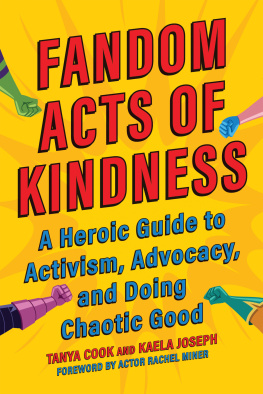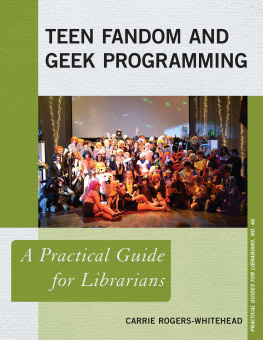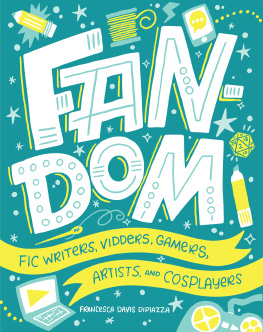Fandom as Methodology
Fandom as Methodology
A Sourcebook for Artists and Writers
Edited by
Catherine Grant and Kate Random Love

2019 Goldsmiths Press
Published in 2019 by Goldsmiths Press
Goldsmiths, University of London, New Cross
London SE14 6NW
Printed and bound by TJ International
Distribution by the MIT Press
Cambridge, Massachusetts, and London, England
Copyright 2019 Catherine Grant and Kate Random Love for selection and editorial material. Chapter copyright belongs to individual contributors.
The right of Catherine Grant and Kate Random Love to be identified as the authors of this work has been asserted by them in accordance with sections 77 and 78 in the Copyright, Designs and Patents Act 1988.
All Rights Reserved. No part of this publication may be reproduced, distributed or transmitted in any form or by any means whatsoever without prior written permission of the publisher, except in the case of brief quotations in critical articles and reviews and certain non-commercial uses permitted by copyright law.
A CIP record for this book is available from the British Library
ISBN 978-1-912685-13-4 (hbk)
ISBN 978-1-912685-14-1 (ebk)
www.gold.ac.uk/goldsmiths-press

d_r0
This book is dedicated to the memory of Liz Hutt:
HIPS LIPS TITS POWER
and every single moon, always.
Contents
Catherine Grant and Kate Random Love
Taylor J. Acosta
Catherine Grant
Dominic Johnson
Artist Pages
Jeremy Deller / Women of Colour Index Reading Group / Ego Ahaiwe Sowinski / Michelle Williams Gamaker / Dawn Mellor / Cathy Lomax / Kamau Amu Patton / Liv Wynter / Zhiyuan Yang / Maria Fusco / Anna Bunting-Branch / Holly Pester
Kate Random Love
Maud Lavin
Owen G. Parry (owko69)
Alice Butler
SooJin Lee
Jenny Lin
Judy Batalion
Ika Willis
There are many people we need to thank, as we had been imagining this book for a long time before it came into being. Most importantly, we would like to thank the writers and artists who have contributed to this collection. Their enthusiasm and creativity in responding to the idea of fandom as methodology has expanded our thinking, and this book has grown through conversations had with many of them. Goldsmiths Press have been immensely supportive of this project, allowing a combination of academic and artistic contributions that would have been impossible with any other academic publisher. So we give grateful thanks to Sarah Kember, Adrian Driscoll, Michelle Lo, Adriana Cloud, Guy Sewell, the designer Ilyanna Kerr and the cover designer Clare Thompson. We would also like to thank the artist Amy Adler for allowing a detail of her artwork BOP, 1994, to be manipulated as part of the cover design. Thanks to Helena Reckitt for suggesting that Goldsmiths Press might be a good home for this book.
A number of people gave vital suggestions for contributors as well as supporting the project in its early stages: Carol Mavor, Jane Blocker, Gavin Butt and Lynn Turner. Maud Lavin needs special thanks for her support and input, both as a key scholar on fandom and art, and for her knowledge of scholarship in East Asia. James Boaden has been in conversation with both of us throughout this project, and his input marks much of what is found here. The comments from the four peer reviewers were invaluable, and we would like to thank the anonymous reviewer as well as Lucy Bradnock, Laura Guy and Jeannine Tang for pushing our thinking, writing and editing. Catherine would like to thank friends in two writing groups who supported and interrogated the writing and ideas found here: Ian Hunt, Susan Kelly, Kristen Kreider, Ros Gray, Wood Roberdeau, Althea Greenan, Jo Stockham, Lara Perry, Lucy Reynolds, Amy Tobin, Helena Reckitt, Flick Allen and Hilary Robinson.
The origins of this book, for us, come through our doctoral work. In this regard, Mignon Nixon deserves much gratitude and thanks, as an inspirational teacher, thinker and writer, supporting both of our earliest explorations into fandom, adolescence and art. Catherine would also like to thank Pat Rubin and the members of the Writing Art History group at the Courtauld Institute of Art (20062009) where much of her work on fandom and art was begun. More recently, we have had support from Goldsmiths, particularly Kristen Kreider in the Art Department, who invited us to organise the seminar Fandom as Methodology in 2018 and Hayley Newman at the Slade School of Art, who invited Kate to organise the seminar Performing Fandom in 2017. The Art Department at Goldsmiths has also provided generous financial support for production of the book, through the Research Support Award. Many thanks go to Stephen Johnstone in this regard, as well as the many conversations about fandom and art with him and other members of the Art Department, in particular Alison Jones, who gave a fascinating paper on her own fandom and art practice for our Fandom as Methodology seminar. Mark Edmondson in the Digital Media Lab at Goldsmiths gave invaluable technical help with some old school technology.
Our friends, colleagues, students and families have heard much about fandom and art in recent years, and we would like to thank all of them for supporting this project and providing examples, suggestions and for believing in our passionate attachments. In particular Catherine would like to thank Francis Summers and Kate would like to thank John Random Love.
Catherine Grant and Kate Random Love
In this introduction, we will explore some histories of fandom in art and art history, relating them to scholarship in fan studies. This does not attempt to be exhaustive but gives the reader some pointers to think through how art and fandom have fertile points of conversation, and how these can enrich contemporary scholarship on art that is currently engaged with discussions around affect, desire, politics and identity.
This collection charts fannish practices in art and art writing from the 1950s to the present, from the queer world of Jack Smith in New York in the 1950s and 1960s to contemporary artists who are reworking celebrity culture, popular music and the legacies of artists, writers and histories that have often been overlooked. To complement the chapters, which themselves range from autobiographical reflections and love letters to more traditional academic theorising, we have commissioned a series of artist pages from practitioners who are working through the idea of fandom as methodology in a wide range of approaches. We see fandom as methodology as allowing for excessive attachments to cultural objects that would otherwise be derided or minimised, which in turn can be important as ways to present a sense of self or community that may not be endorsed in mainstream culture, whether that is inside or outside the art gallery. This equation is flipped by a number of artists and writers in this collection, who also utilise fandom as a way of passionately (lovingly, angrily, slavishly) reworking canonised icons, histories and objects to reveal what might be missing in more conventional approaches.
This book stems from our own scholarship and passionate engagement with fandom in and around art. We (the editors) have both written about how artists take up the role of the fan, and reflected on how fandom provides a model for subjective and emotionally driven engagement with contemporary art as writers.









